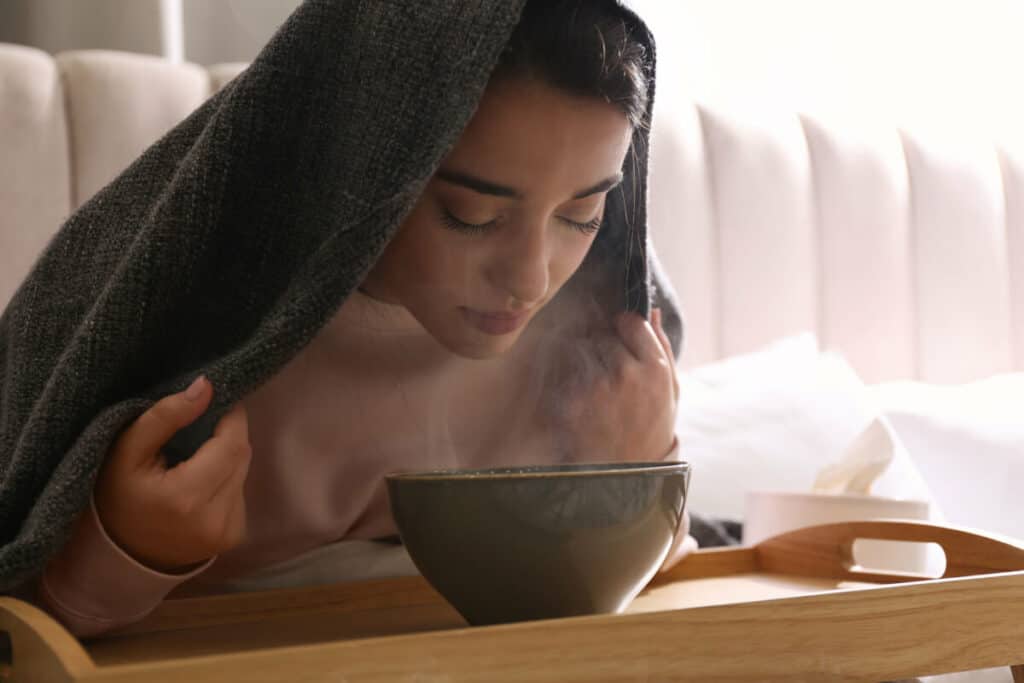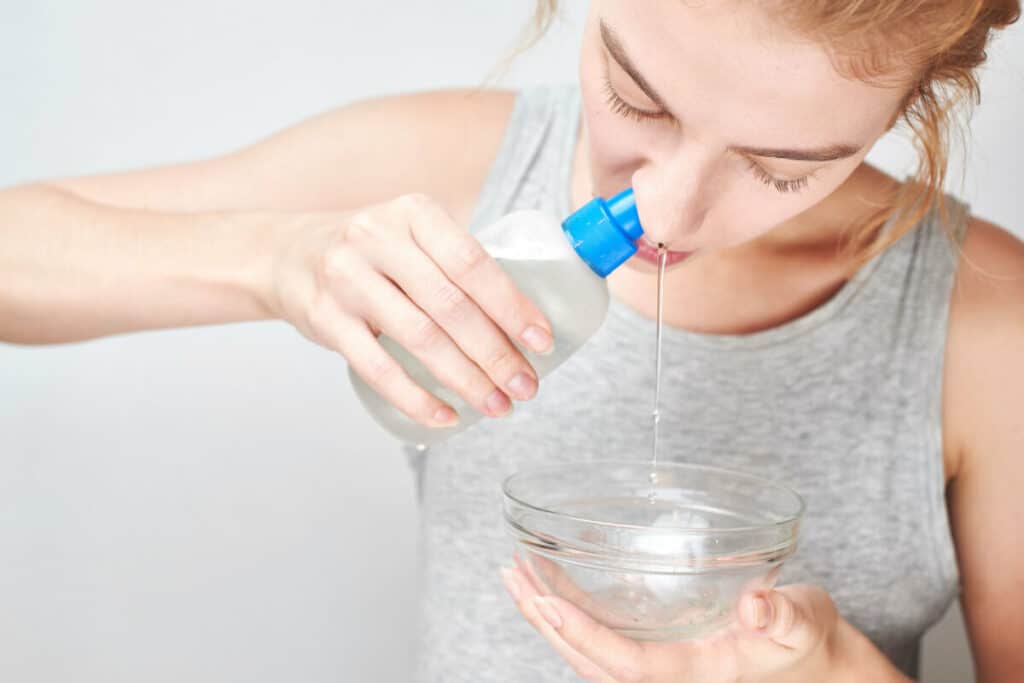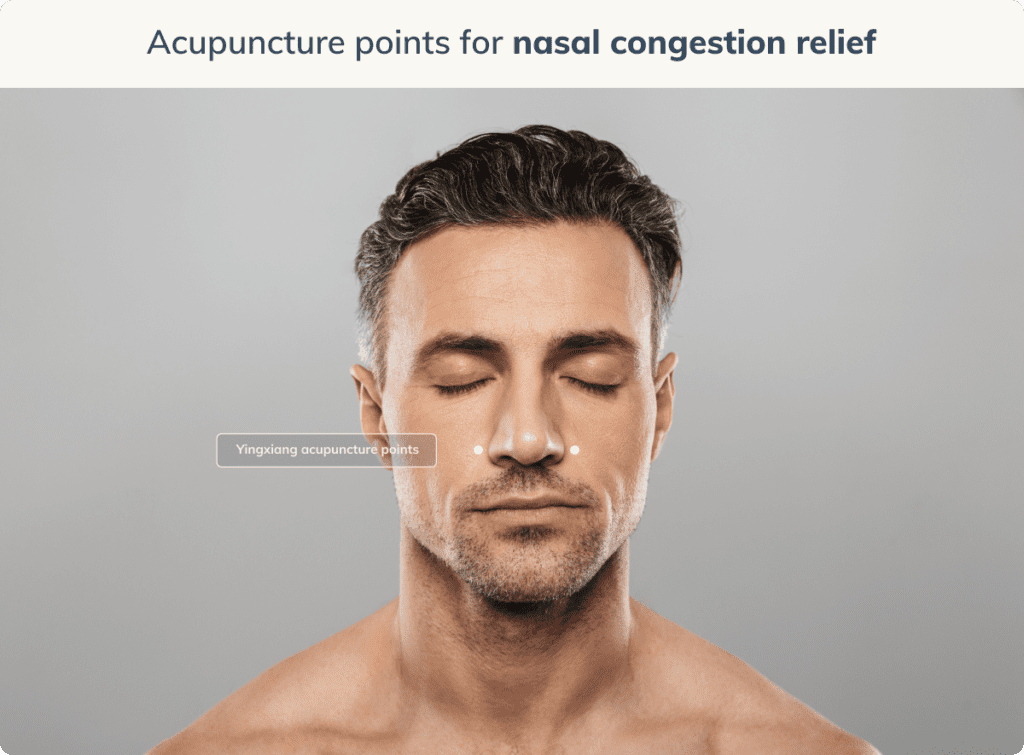Nasal congestion, commonly known as a blocked or stuffy nose, is a common condition where airflow through the nasal passages is restricted as a result of swelling or structural narrowing. Difficulty breathing, nasal discharge (a “runny nose”), and sinus congestion are a few associated symptoms with nasal congestion that can impact quality of life. (16)

What causes nasal congestion?
Common causes of nasal congestion can be broken down into two main categories: inflammatory and structural. Inflammatory causes can be further broken down into allergic or non-allergic. (10)
Allergic
An allergy occurs when your immune system reacts to something that is, generally speaking, harmless. This could be pollen, dust, mold, pet dander, and food. Hay fever, medically known as allergic rhinitis, is a type of rhinitis, or inflammation of the nose, that can cause nasal congestion. (5)
Allergens, small particles in the air, make their way through the nostrils into the nasal cavity. Here you may catch the allergen in your nose hairs or sneeze to remove them from your body. However, when the allergen makes it past these defenses, your immune system activates an inflammatory response sending blood and mucus to your nose to swell up and wash away the allergens. The swelling and mucus leads to you being “stuffed up.” (10)
Allergic rhinitis can be intermittent, happening less frequently, or persistent, in which symptoms occur most days in a week. The blocked nose will most likely be in both nostrils and associated symptoms may include the aforementioned sneezing, itchiness, and irritated eyes. (2)
Non-allergic
Similar to allergic causes, exposure to a particular trigger is the cause of the blocked nose and both nostrils will be congested. An infection, likely viral (e.g., the common cold), is a common cause of non-allergic nasal congestion. Other triggers include:
- The environment: smoke, scents, stress
- Medications: those that treat high blood pressure (e.g., ACE inhibitors and beta-blockers) and nonsteroidal anti-inflammatories (NSAIDs) (e.g., aspirin, ibuprofen and naproxen)
- Hormonal changes: puberty and pregnancy (11)
Structural
A standout feature of structural congestion is that it commonly affects only one nostril. A deviated septum, foreign bodies (something stuck in your nose that shouldn’t be there, which is common in children), and nasal polyps can all cause one-sided nasal congestion. Swollen adenoids, immune tissues with a similar function to tonsils, are also a structural cause of nasal congestion, but in this case the symptoms will be in both nostrils. (2)
Did you know? Your body’s position is your friend when it comes to a blocked nose. Being upright, either standing or sitting, means that mucus can drain down. That’s why at night, when you’re in a horizontal position, your nose gets even more congested. (17)
Nasal congestion treatment
Depending on the cause of your blocked nose, the congestion can resolve quickly or stick around and become bothersome. In cases of infections and short-term exposure to allergens and triggers, congestion will likely resolve itself. Chronic (long-term) exposure and structural abnormalities can mean that congestion becomes a daily challenge. (7)
Ideally, if the trigger or abnormality can be removed or solved, that would be the best approach—to treat the cause. However, as this is not always possible, what you can do is use methods that:
- Thin mucus
- Wash your nasal passages
- Treat allergies
- Lower inflammation (7)
1. Steam inhalation
As a common home remedy, steam inhalation has been shown to improve nasal obstruction. The inhalation of hot, humid air warms and moistens your nasal passages. In turn, this reduces the amount of mucus released and the mucus and phlegm becomes thinner making it easier to blow your nose to remove the build-up. Steam inhalation can almost instantly unclog your nose and may improve other symptoms such as sneezing and headache. Steam inhalation may be especially effective in treating allergy associated nasal congestion. Studies suggest steam inhalation may have the ability to decrease the sensitivity of immune systems to allergens. (19) Caution should be taken as scalding and burns are possible, primarily due to contact with the hot water used. (13)

How to perform steam inhalation
- Place a bowl of hot water (e.g., from a kettle) on your table.
- Sit close to the table with your head 9 to 12 inches (23 to 30 centimeters) over the bowl of water. Drape a towel over your head and bowl, creating a tent to keep the steam in.
- Take deep breaths, through both your nose and mouth. Keep a tissue nearby to blow your nose.
- Stay under the towel for five to ten minutes, being careful to avoid direct contact with the hot water. (4)
Note: essential oils can be added such as one to two drops of eucalyptus, which may provide additional relief. Eucalyptus may act as an anti-inflammatory and anti-bacterial agent. (14)
For children, steam inhalation using the bowl and towel method is not recommended. (1) Rather, taking a warm bath or shower or using a humidifier in a closed room may provide a similar benefit. Avoid using essential oils in children.
2. Saline nasal wash
A saline solution nasal wash involves flushing the nasal passages and sinus spaces with a saltwater solution. (4) This treatment originates from Ayurvedic medicine where a technique known as Jala Neti is practiced to cleanse the nasal passages for yoga. (8) The namesake device, a neti pot, or other devices available at the drugstore such as a squeeze bottle or nasal bulb can be used to perform the wash. (6)
The benefits of the wash include:
- Dissolving mucus, phlegm, and other debris and washing them away
- Drying the passages, which decongests by reducing swelling
- Improving your natural mechanism to expel contents from the nose (12)
How to perform a saline nasal wash
- Add 1 tsp of canning or pickling salt (no iodine) and a pinch of baking soda to 2 cups (0.5 L) of warm distilled, filtered, or boiled water that has been left to cool (note: tap water may contain germs and therefore should be avoided). Mix until dissolved.
- Fill the device of your choice (e.g., neti pot or nasal bulb) with the salt water mixture.
- With your head tilted to one side over a sink, drain the fluid through one nostril such that it flows through one nostril and out the other (see image below for illustration).
- Repeat on the other side. (6)

3. Acupressure
Using the same approach as acupuncture, acupressure employs the use of gentle pressure rather than needles to stimulate specific acupuncture points. Acupuncture points are locations on the body identified in Traditional Chinese Medicine that can modulate the flow of Qi throughout the body. In other words, acupuncture points are sensitive to and can conduct the body’s electrical impulses. Stimulation of these points can result in physical responses such as endorphin release and increased blood flow. (9) Endorphins are chemicals in your body that reduce pain and increase pleasure. (15)

For nasal congestion, acupressure on the yingxiang point or Large Intestine 20 (LI20) point may help provide relief, increase your ability to breathe easier, (18) and improve your sleep quality. (3) Yingxiang is located at the corners of the nostrils. Simply find the point with the pad of your index finger and perform a massage by drawing small circles for 30 seconds. Relief for a blocked nose typically occurs after about two minutes. (18)
The bottom line
Nasal congestion is a bothersome symptom, and methods that provide quick relief can make a big impact on quality of life. From structural to inflammatory factors, allergen to non-allergen, the causes of nasal congestion should be investigated to provide a long-term solution. Quick techniques including steam inhalation, saline rinses, and acupressure can provide instant relief at home.
- Akhavani, M. A., Baker R. H. J. (2005). Steam inhalation treatment for children. British Journal of General Practice, 55(516), 557.
- Krouse, J. (2010). Diagnostic strategies in nasal congestion. International Journal of General Medicine, 59.
- Lei, R. L., Lin, W. C., Lin, C. C., & Lei, R. W. (2020). Effects of Acupressure on Symptoms Relief and Improving Sleep Quality in Pediatric Patients With Allergic Rhinitis. Holistic Nursing Practice, 36(3), 166–174.
- Little, P., Stuart, B., Mullee, M., Thomas, T., Johnson, S., Leydon, G., Rabago, D., Richards-Hall, S., Williamson, I., Yao, G., Raftery, J., Zhu, S., & Moore, M. (2016). Effectiveness of steam inhalation and nasal irrigation for chronic or recurrent sinus symptoms in primary care: a pragmatic randomized controlled trial. Canadian Medical Association Journal, 188(13), 940–949.
- MedlinePlus . Bethesda (MD): National Library of Medicine (US). (2022) Allergic rhinitis. https://medlineplus.gov/ency/article/000813.htm
- MedlinePlus . Bethesda (MD): National Library of Medicine (US). (2021) Saline nasal washes. https://medlineplus.gov/ency/patientinstructions/000801.htm
- MedlinePlus . Bethesda (MD): National Library of Medicine (US). (2021). Stuffy or runny nose – adult. https://medlineplus.gov/ency/article/003049.htm
- Meera, S., Vandana Rani, M., Sreedhar, C., & Robin, D. T. (2020). A review on the therapeutic effects of Neti Kriya with special reference to Jala Neti. Journal of Ayurveda and Integrative Medicine, 11(2), 185–189.
- Mehta, P., Dhapte, V., Kadam, S., & Dhapte, V. (2017). Contemporary acupressure therapy: Adroit cure for painless recovery of therapeutic ailments. Journal of Traditional and Complementary Medicine, 7(2), 251–263.
- Naclerio, R. (2010). Pathophysiology of nasal congestion. International Journal of General Medicine, 47.
- National Health Service. (2022). Non-allergic rhinitis. https://www.nhs.uk/conditions/non-allergic-rhinitis/
- Principi, N., & Esposito, S. (2017). Nasal Irrigation: An Imprecisely Defined Medical Procedure. International Journal of Environmental Research and Public Health, 14(5), 516.
- Scarborough, A., Scarborough, O., Abdi, H., & Atkins, J. (2021). Steam inhalation: More harm than good? Perspective from a UK burns centre. Burns, 47(3), 721–727.
- Serafino, A., Vallebona, P., Andreola, F., Zonfrillo, M., Mercuri, L., Federici, M., Rasi, G., Garaci, E., & Pierimarchi, P. (2008). Stimulatory effect of Eucalyptus essential oil on innate cell-mediated immune response. BMC Immunology, 9(1), 17.
- Sprouse-Blum, A. S., Smith, G., Sugai, D., & Parsa, F. D. (2010). Understanding endorphins and their importance in pain management. Hawaii medical journal, 69(3), 70–71.
- Stewart, M. G. (2010). Epidemiology and burden of nasal congestion. International Journal of General Medicine, 37.
- Stroud, R. H., Wright, S. T., & Calhoun, K. H. (1999). Nocturnal Nasal Congestion and Nasal Resistance. The Laryngoscope, 109(9), 1450–1453.
- Takeuchi, H., Jawad, M. S., & Eccles, R. (1999). The Effects of Nasal Massage of the “Yingxiang” Acupuncture Point on Nasal Airway Resistance and Sensation of Nasal Airflow in Patients with Nasal Congestion Associated with Acute Upper Respiratory Tract Infection. American Journal of Rhinology, 13(2), 77–80.
- Vathanophas, V., Pattamakajonpong, P., Assanasen, P., & Suwanwech, T. (2021). The effect of steam inhalation on nasal obstruction in patients with allergic rhinitis. Asian Pacific journal of allergy and immunology, 39(4), 304–308.





